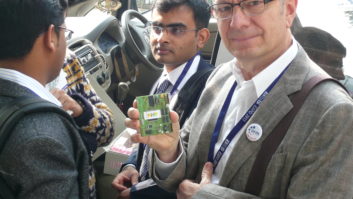
ABERT President Daniel Slaviero The U.S. radio industry is not the only one exploring ways to help AM broadcasters.
Brazil radio observers expect their government to publish a decree in November detailing an optional migration process for AM radio to the FM band. In cities where the FM spectrum can’t accommodate new channels, it will be necessary to extend the spectrum using television Channels5 and 6.
Brazil — the largest country in South America and home to the world’s fifth-largest population — has about 1,800 AM stations.
Brazilian President Dilma Rousseff okayed the migration concept in June, and the Ministry of Communications formulated an outline this summer and early fall. Rousseff was expected to sign off on the actual plan in November.
As we’ve reported, Brazil sought to settle the AM migration issue before deciding on a digital radio standard or standards for shortwave, AM and FM. In pursuing this plan, the nation follows partially in the footsteps of Mexico, which approved a voluntary AM migration plan this year. Approximately 540 AMs there plan to migrate to FM.
Daniel Slaviero, president of the Brazilian Association of Radio and Television Broadcasters (ABERT), talked with RWI freelancer Carlos Eduardo Behrensdorf about what led to the AM migration decision and how the moves would proceed.
RW: What do proponents say are the advantages of migration?
Slaviero: ABERT and the state associations of broadcasters view the migration as critical to the future of AM radio. On the FM band, [AM] broadcasters will gain transmission quality. Being located in a lower position in the spectrum, the AM band is very susceptible to noise and interference, which increases with the urbanization. Also, the mechanical noise caused by electrical networks and factories, for example, generates spectral “noise” in the frequency bands, and AM radio is the first to be affected, followed by shortwave. The interference also affects other bands used for broadcasting, but with less intensity.
The migration will also enable broadcasters to get better integrated in the current context of technological convergence. The technical characteristics of signal reception, especially the need to use large antennas to capture the signal, have hindered the reach of AM radio. For example, cell phones have FM reception. But many vehicles leave the factory already without a medium-wave receiver.
RW: How many broadcasters would move and what is the timeframe?
Slaviero: Since the migration is optional and costly, we don’t have a ballpark figure of how many broadcasters will move. The government estimates that the decree, containing the rules for the reallocation, will be published this month. Therefore, the migration could be expected to begin in early 2014. In small towns where there is space on the dial, the AM stations will immediately move to frequency modulation. But in large cities, where the spectrum is crowded, it will be necessary to extend the spectrum of the FM band to television Channels 5 and 6. In this case, the migration will take place gradually as these channels get released after the analog television signal is turned off, which will occur between 2015 and 2018.
RW: Who conceived and led this effort and how did they win the support of broadcasters?
Slaviero: Given the problems that AM radio faces, ABERT and the state broadcasting entities agreed that the best solution for the AM is migration. We proposed the migration to the government, which is now responding favorably to the petition of the broadcasting industry.
RW: Was migration a contentious issue?
Slaviero: No. There is a consensus that the most important thing is to rescue the AM radio and to ensure the provision of services, with more quality to the listeners. The migration will strengthen the radio industry as new media emerge and begin to take away attention from the traditional media.
RW: How will AM stations pay for the costs of the transition? Is the government offering a subsidy?
Slaviero: The government is not offering a subsidy. ABERT supports access to financing options, but we have not gotten a reply from the government regarding this issue yet. There is a clear indication that the broadcasters will have to pay the price difference between the basic AM or FM license, established according to the station power, coverage area, etc. We are talking about the minimum cost of the license, set in the previous ordinance.
RW: Besides cost, what other obstacles will individual stations face?
Slaviero: The broadcasters will have to pay for the costs incurred from any technological change. Basically the stations will need to invest in order to adapt their transmission systems.
RW: Are there sufficient receivers in the marketplace for stations to be heard? Will there be a campaign to expand the number of FM receivers capable of receiving these stations?
Slaviero: In the cities where there is no need to expand the dial, listeners will receive the signal in their current receiver. On the other hand, in cities where the television Channels 5 and 6 will be used, it will be necessary to increase the number of receivers. There are already receivers in the market capable of receiving the signal. Some new equipment will only require a software upgrade — for example, some new cell phones. This will be a gradual change and the manufacturers will have to adapt to the frequency spectrum. That’s why there will be a simulcasting period when broadcasters will operate in AM and FM simultaneously.
RW: What will happen to the vacated AM spectrum?
Slaviero: The vacated spectrum will be returned to the government and they will conduct the appropriate research on new uses for the band. But since the migration is optional, and not all broadcasters will make the transition, this spectrum will continue to be used for the AM band.
RW: For countries that may be considering such a migration, what do broadcasters and regulators need to know or be aware of?
Slaviero: It is crucial to examine the regulations and to talk extensively about the issue with every party involved. You should be aware that the FM spectrum may not be sufficient to accommodate the migration, so it will be necessary to make some changes, as is the case of Brazil, which will extend the range of frequency modulation to the TV Channels 5 and 6.
In Mexico, for example, the migration took place only in the cities where it was possible to do it on the dial. In the cities where there was no space, the change was not implemented and they have no plans for the near future. We can say that in Mexico only one part of the process was finished.
RW: Would you like to add anything else?
Slaviero: Hopefully this semester the Congress will review the government’s proposal and will publish a law.
The migration is very important for Brazilian radio. We are [talking about] a robust market, with more than 4,500 commercial radio stations — from these, 1,800 are AMs — and 200 million conventional receivers.
Radio in Brazil reaches approximately 50 million households (88.9 percent) and, contrary to what one might think, its presence in day-to-day lives grows, favored by the Internet and various devices such as computers, cell phones, iPods, MP4s and tablets. These devices are helping to expand the reach of radio, which now can be heard in new ways. Once the quality of the sound and the scope of the reach are guaranteed, our stations should constantly strive to improve their content and therefore maintain the relevance of the media.







